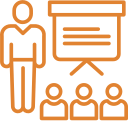ROI and Critical Issues
Clear evidence is needed that consulting makes a difference in terms that executives and sponsors can clearly understand and appreciate – impact and ROI. The problem is that when executives see something as a cost and not an investment, they tend to cut it, pause it, freeze it, or eliminate it. If they see something as an investment, they support it, protect it, and enhance it. If the value of consulting is not shown in terms that executives can understand and appreciate, they will classify it as a cost. This situation must change.
New external consultants entering the field have a very high failure rate, representing one of the highest failure rates of any professional occupation. Some have estimated as many as 80% of new consultants fail in the first two years.
Although a variety of reasons cause this, three critical issues top the list:
- Lack of connection to the business and failure to deliver the proper solution.
- Ineffective management of the costs.
- The inability to show the value of consulting.
With proper skill-building, consultants can rectify these issues.
Where Do Consultants Fail?
Most consultants enter the field with good intentions and aim to be successful but often become frustrated in the process. The problem is that the consultants don’t necessarily know how to adequately align a particular project to a business need and focus on the business need throughout the effort. Sometimes, the wrong solution is implemented – relying on their “favorite” solution. The result is a disappointing outcome. Often, consultants lack the knowledge and experience to show the value of their work in terms that executives desire. Connecting the consulting project directly to business impact and converting it to the financial ROI is not something consultants have been trained to do. In today’s climate, consultants must focus squarely on this issue.
ROI’s Biggest Concern
One of the biggest concerns in measuring the impact and ROI of consulting is the fear of negative ROI. There is a concern that if the project is not adding value, this kind of study will expose it. Otherwise, the client might not be aware of this. This is a short-sighted view, and the best way to resolve the concern about disappointing results is a two-fold process. First, be proactive with the consulting process and drive the improvement before being asked of the consultant. The second is to design the consulting project to deliver ROI, using design thinking principles. Consulting projects can be designed to deliver the desired impact and even a positive ROI. This involves, essentially, beginning with the end in mind, and the end is a precise business impact measure.
The Solution
The ROI Methodology® is ideal for this situation. It not only captures the data for the consulting success of a project, including impact and ROI, but it also uses design thinking processes to deliver value from the beginning and throughout the process.
The methodology captures five levels of outcomes:
- Level 1 – Reaction to the services
- Level 2 – Learning to use the services
- Level 3 – Application by using the services
- Level 4 – Impact of the services in the organization
- Level 5 – ROI, the monetary value of the impacts compared to the costs of the program
Along the way, 12 guiding principles guide this value chain to ensure that the data collection, analysis, and reporting are credible and conservative.
The ROI Methodology has enjoyed over three decades of use and growth. It is now the most used evaluation system globally, with more than 6,000 organizations systematically and routinely using it. This process has been adopted by three-fourths of the Fortune 500 organizations and other significant organizations worldwide, including The United Nations, which adopted it as the evaluation system of choice with a UN General Assembly Resolution in 2008. Twenty-six federal governments, over 300 healthcare associations, 150 universities, and many nonprofits, charities, and faith-based organizations have adopted this process.
















